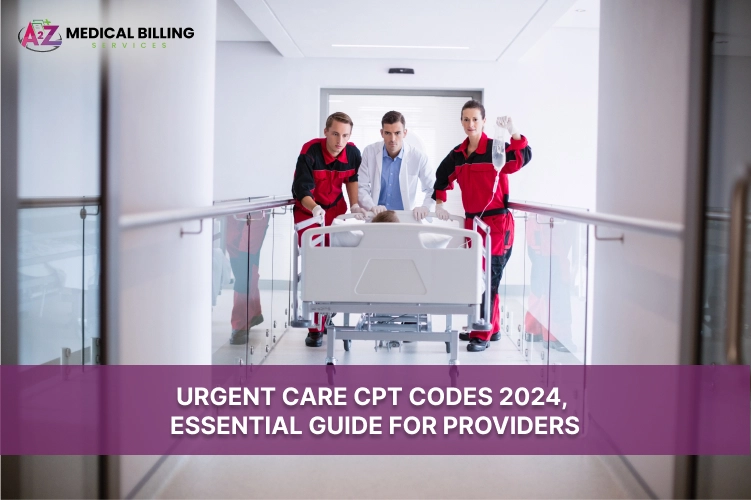Current Procedural Terminology (CPT) codes are crucial for billing and insurance processes in urgent care. Accurate application of CPT codes is important for the reimbursement process and the financial health of medical practices.
CPT codes used in urgent care, discuss the changes for 2024 and explain how these affect billing and insurance claims. It will help healthcare providers maintain compliance and improve operational efficiency.
The guide helps streamline administrative processes and enhance patient care by improving coding accuracy and addressing billing errors.
Understanding Urgent Care CPT Codes
CPT codes are essential for the billing processes in urgent care. This section clarifies why these codes are important and how they impact service delivery and billing accuracy.
Why Do CPT Codes for Urgent Care Matter?
Current Procedural Terminology (CPT) codes explain a fundamental role in the medical billing cycle, particularly in urgent care settings. Where a wide range of services are provided on an unpredictable basis. Here’s why understanding and using the correct “urgent care CPT codes” is crucial:
- Facilitates Accurate Billing: CPT codes help ensure that healthcare providers are billed correctly for their services. This is crucial in urgent care, where many treatments are offered and billing can become complex.
- Ensures Timely Reimbursement: Using the correct CPT codes speeds up the reimbursement process from insurance companies. Accurate coding reduces the chances of claim rejections and denials, which are critical for maintaining the operational efficiency of urgent care centers.
- Compliance with Regulations: Accurate use of “urgent care CPT codes” ensures compliance with health insurance policies and regulations. This protects the facility from potential legal and financial penalties associated with non-compliance.
- Streamlines Patient Care: Efficient coding helps streamline the administrative aspects of patient care, allowing healthcare providers to focus more on patient treatment rather than complex billing.
Essential CPT Codes for Urgent Care in 2024
This section outlines the key CPT codes used in urgent care settings for 2024, ensuring healthcare providers can effectively manage billing and compliance with current standards.
List of Common Evaluation and Management Codes
Evaluation and Management (E/M) codes are critical for billing various patient interactions within urgent care. Here is an updated list for 2024, focusing on the most commonly utilized codes:
| CPT Codes | Description |
| 99201 | Office or another outpatient visit for any assessment and management of a new patient; and least complex visits. |
| 99202 | Office or other outpatient visits for a new patient; require a slightly higher level of decision-making due to more complex medical issues. |
| 99211 | Office visit for an established patient; minimal issues requiring a brief check-up. |
| 99212 | Office visit for an established patient; with straightforward medical conditions. |
| 99213 | Office visit for an established patient; moderately complex evaluation. |
| 99214 | Office visit for an established patient; more extensive evaluation and moderately complex medical decision-making. |
| 99215 | Office visit for an established patient; most complex cases involving comprehensive assessment. |
List of Procedure-Specific CPT Codes
Procedure-specific CPT codes detail the more technical aspects of medical care provided in urgent care settings. These codes ensure accurate billing for procedures beyond basic evaluations:
| CPT Codes | Description |
| 10060 | Incision and drainage of an abscess; simple or single |
| 10120 | Incision and removal of foreign body, subcutaneous tissues; simple. |
| 12002 | Suture of small wounds (2.5 cm or less) involving the epidermis and dermis |
| 29105 | Application of a short arm splint (forearm to hand); static. |
| 73080 | Radiologic examination, of the elbow; complete. |
| 87804 | Infectious agent detection by immunoassay with direct optical observation; influenza. |
| 90732 | Pneumococcal polysaccharide vaccine 23-valent, adult or immunosuppressed patient dosage, when administered. |
List of Common Modifiers for Urgent Care CPT Codes
Modifiers are used to provide additional information about the service or procedure performed and are crucial for accurate billing and reimbursement.
| Modifier | Description |
| -25 | Significant, separately identifiable evaluation and management service by the same physician on the same day of the procedure or other service. Use when any procedure and an E/M service are provided on the same day. |
| -59 | Distinct procedural service. Indicates that a procedure or service was distinct or independent from other services performed on the same day. |
| -76 | Repeat the procedure by the same physician. Use of the procedure is repeated on the same day by the same physician. |
| -51 | Multiple procedures. Use when more procedures are performed during the same surgical session. |
| -X{EPSU} | The subset of the -59 modifier, is used to define specific situations like separate encounters, separate structures, or separate practitioners. |
| -95 | Synchronous telemedicine service is rendered via a real-time interactive audio and video telecommunications system. |
Best Practices for Applying CPT Codes in Urgent Care
Effective application of CPT codes is crucial for accurate billing and compliance in urgent care settings. This section covers how to select the right codes and avoid common errors.
How to Choose the Correct CPT Code
Choosing the correct CPT code is fundamental to ensuring proper billing and reimbursement. Here are key considerations:
- Understand the Patient’s Visit: Determine the complexity of the visit. Consider factors like the patient’s medical history, the reason for the visit, and the level of examination required.
- Review the Service Provided: Match the services provided during the visit to the appropriate CPT codes. Be specific about procedures and any additional services rendered.
- Consult Updated CPT Guidelines: Regularly review the latest CPT manual or digital updates for any changes in coding practices relevant to urgent care.
Tips to Avoid Common Coding Errors
Coding errors can lead to claim rejections and delays in reimbursement. Here are effective strategies to minimize mistakes:
- Double-check codes Before Submission: Always verify codes against current coding guidelines to ensure accuracy.
- Use Modifiers Correctly: Understand when and how to apply modifiers. Modifier 25, for instance, is crucial for billing separate procedures performed on the same day.
- Educate Staff Regularly: Conduct ongoing training for all coding and billing staff to keep updated on the latest CPT code changes and billing practices.
Understanding Regulatory Changes in CPT Coding for Urgent Care CPT Codes
Regulatory updates to CPT codes directly affect urgent care billing and compliance. This section explores the latest changes and their impact on medical practices.
2024 Updates to Urgent Care CPT Codes
The 2024 revisions to “Urgent care CPT codes” involve several significant changes intended to streamline billing processes and improve the accuracy of claims. Here are the new updates:
- Introduction of New Codes: Several new CPT codes have been introduced to cater to emerging medical technologies and techniques.
- Revisions to Existing Codes: Updates to existing codes reflect the changes in medical practice and technology.
- Deletions: Outdated codes have been removed to maintain the relevance and efficiency of the coding system.
Impact of Regulatory Changes on Billing
Understanding the impact of these regulatory changes on billing is crucial for healthcare providers in urgent care settings. Here’s how the updates can affect your practice:
- Billing Accuracy: Updated codes require careful integration into your practice’s billing system to ensure accuracy and prevent claim denials.
- Reimbursement Rates: Changes in CPT codes can affect reimbursement rates, which may require adjustments in billing strategies to optimize revenue.
- Compliance: Staying with the latest CPT codes is essential to avoid legal and financial penalties. Regular training for coding staff is recommended.
Conclusion
This guide to “Urgent Care CPT Codes” 2024 provides healthcare providers, medical billers, and coders with the critical information needed to manage billing and compliance effectively. By understanding and applying the updated CPT codes, urgent care professionals can improve billing accuracy, ensure timely reimbursements, and comply with regulatory standards. These practices will optimize financial outcomes and allow providers to focus more on delivering quality patient care.
FAQs
1. What are CPT codes in urgent care?
CPT codes categorize medical services to ensure accurate billing and compliance in urgent care settings.
2. How do the 2024 updates to urgent care CPT codes affect medical billing?
The 2024 updates introduce new codes and revise existing ones to improve billing accuracy and compliance.
3. Why is it important to use the correct urgent care CPT codes?
Using correct CPT codes ensures timely reimbursement and helps avoid legal and financial penalties.
4. What are some common CPT codes used in urgent care for 2024?
Common codes include 99201-99215 for patient visits and 10060, 10120 for specific procedures.
5. How can I avoid common coding errors in urgent care?
Double-check codes before submission and ensure staff are trained on the latest CPT guidelines.



